Specifications
Small missile ships of the Project 1234 according to NATO classification a Nanuchka-class corvette is a series of Soviet small missile ships (MRK) of the third rank built at shipyards of the USSR from 1967 to 1992. [1]
The type consists of three series of subprojects:
- Project 1234, NATO code Nanuchka I
- Project 1234E, NATO code Nanuchka II
- Project 1234.1, NATO code Nanuchka III
- Project 1234.7, NATO code Nanuchka IV
By the name of the project code, the ships received the nickname gadflies in the navy. IRAs of Project 1234 were supplied to the Navy of four countries of the world: the USSR, Algeria, Libya and India. Libyan ones were destroyed during the NATO military operation in the summer of 2011; Indian ships of this project were withdrawn from the Indian Navy in 1999-2004.
The ships of the project were actively operated in all four fleets of the Soviet Navy and during the 1970-1980s carried out combat services in the World Ocean. They left a noticeable mark on the history of Soviet shipbuilding and are currently being gradually withdrawn from the combat strength of the Russian fleet. [1] So, if at the beginning of 2001 in the Russian Navy there were 2 ships of project 1234 and 18 ships of Project 1234.1, [2] then by 2006 all ships of project 1234 were withdrawn from the Navy and only 12 ships of the project remained in Project 1234.1 and 1 ship of Project 1234.7. [3] [4]

The Tarantul-class corvette, Soviet designation Project 1241 Molniya are a class of Russian missile corvettes.

The Libyan Navy is the naval warfare branch of the Libyan Armed Forces. Established in November 1962, Libyan Navy was headed by Admiral Mansour Bader, Chief of Staff of the Libyan Naval Force. Before the First Libyan Civil War, it was a fairly typical small navy with a few missile frigates, corvettes and patrol boats to defend the coastline, but with a very limited self-defence capability.

The Baltic Fleet is the fleet of the Russian Navy in the Baltic Sea.

The Koni class is the NATO reporting name for an anti-submarine warfare frigate built by the Soviet Union. They were known in the Soviet Union as Project 1159 Del'fin. 14 were built in Zelenodolsk shipyard between 1975 and 1988. They were originally intended to replace the older Riga-class frigates, but were instead chosen as a design for export to various friendly navies. The Koni I sub class were designed for European waters and the Koni II were made for warmer waters. One ship was retained by the Soviets in the Black Sea for training foreign crews. Only a few of these vessels remain in service today.

The Nanuchka class, Soviet designation Project 1234 Ovod, are series of corvettes built for the Soviet Navy and export customers between 1969 and 1991.
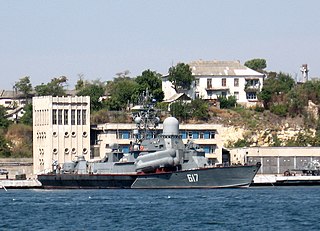
The Battle off the coast of Abkhazia was a supposed naval engagement between warships of the Russian Black Sea Fleet and Georgian patrol boats during the Russo-Georgian War.

The Matka class is the NATO reporting name for a group of hydrofoil missile boats built for the Soviet Navy. The Soviet designation was Project 206MR Vikhr. Following the 1997 Black Sea Fleet partition treaty all Black Sea Fleet Matka class boats were passed to the Ukrainian Navy.

The MRK-23 is a Nanuchka-class corvette in the Soviet Navy and later transferred in 1981 to the Algerian National Navy as Salah Rais (802).
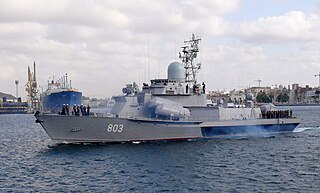
The MRK-22 is a Nanuchka-class corvette in the Soviet Navy and later transferred in 1981 to the Algerian National Navy as Reis Ali (803).
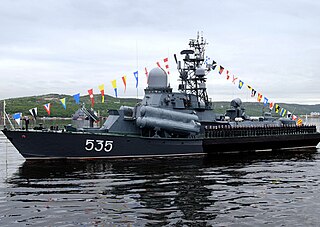
Aysberg was a Nanuchka-class corvette in the Soviet Navy and later the Russian Navy.
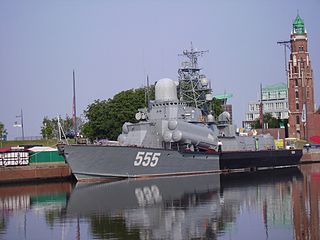
Geyzer is a Nanuchka-class corvette in the Soviet Navy and later the Russian Navy.

Iney is a Nanuchka-class corvette in the Soviet Navy and later the Russian Navy.

Livien' is a Nanuchka-class corvette in the Russian Navy.

Moroz was a Nanuchka-class corvette in the Soviet Navy and later the Russian Navy.

Passat is a Nanuchka-class corvette in the Soviet Navy and later the Russian Navy.

Rassvyet is a Nanuchka-class corvette in the Soviet Navy and later the Russian Navy.

Razliv is a Nanuchka-class corvette in the Russian Navy.
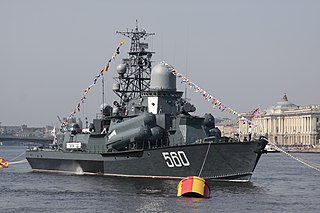
Zyb' is a Nanuchka-class corvette in the Russian Navy.

Shtil' was a Nanuchka-class corvette in the Soviet Navy and later the Russian Navy.
Chernihiv(U205) was a Grisha II-class anti-submarine corvette of the Ukrainian Navy. Prior to joining the Ukrainian Navy she was a former Soviet Navy corvette named Izmail.
This page is based on this
Wikipedia article Text is available under the
CC BY-SA 4.0 license; additional terms may apply.
Images, videos and audio are available under their respective licenses.



















